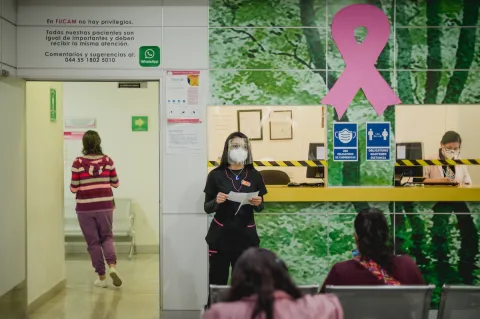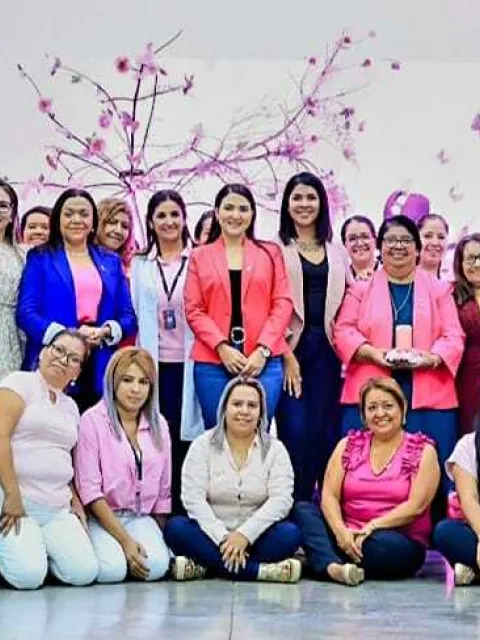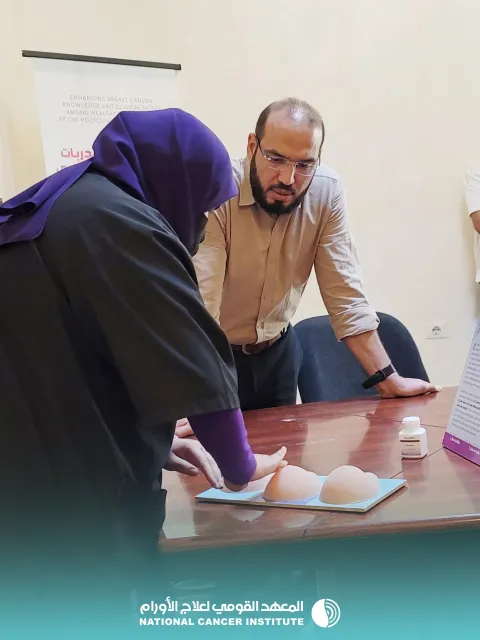
In this podcast episode, Dr Lydia Pace speaks about the global rise in breast cancer cases, the significant disparities in survival rates between income settings, promising innovations and male breast cancer.
Since 2020, breast cancer has surpassed lung cancer as the most diagnosed cancer worldwide. With improvements in detecting and treating many types of breast cancer, however, survival rates have risen significantly, up to 90% in some cases – but mainly in high-income settings. In low- and middle-income countries, where a majority of breast cancers are diagnosed late, survival rates remain low.
What are some of the reasons for the global rise in breast cancer cases? How can we improve the early detection of breast cancer and treat it more successfully? What are some of the promising innovations that will further help fight this disease and how can they be applied in low-income settings? How can we address the stigma that often surrounds breast cancer? And what about the rare case of male breast cancer?
On the occasion of Breast Cancer Awareness Month, Dr Lydia Pace, Assistant Professor of Medicine at Harvard Medical School and Brigham And Women's Hospital in Boston, Massachusetts, lends her expertise answering these questions in this podcast with Nicole Engelbrecht, Head of Communications and Marketing at UICC.
"Many resource constrained health systems are ill prepared to deal with breast cancer. So this is a really opportune moment to talk about these issues and try to strategise about how to address global inequity and breast cancer mortality."
– Dr Lydia Pace, Assistant Professor of Medicine at Harvard Medical School and Brigham And Women's Hospital in Boston, Massachusetts
See podcast transcript below
Listen on: Spotify | Stitcher | Apple Podcasts | Amazon Music | Audible | Deezer
Podcast transcript
Nicole Engelbrecht, Head of Communications and Marketing, UICC
Hello, Welcome to Let's Talk Cancer by the Union for International Cancer Control, an organization that unites and supports the cancer community to reduce the global cancer burden. I'm Nicole Engelbrecht, Head of Communications and Marketing at UICC. Breast cancer is today the most commonly diagnosed cancer type in the world and it is the most common cause of cancer death in women. With improvements in detecting and treating many types of breast cancer survival rates have risen significantly, up to 90% in some countries, but mainly in high income settings. In low-and middle-income countries where a majority of breast cancers are diagnosed late, survival rates remain low. What are some of the reasons for the global rise in breast cancer cases? How can we improve the early detection of breast cancer and treat it more successfully also in low-income settings? How can we address the stigma that often surrounds breast cancer? And what about the rare case of male breast cancer? With us to discuss all this on the occasion of Breast Cancer Awareness Month is Dr. Lydia Pace Assistant Professor of Medicine at Harvard Medical School and Brigham and Women's Hospital in Boston in the United States. Welcome, Dr. Pace.
Dr Lydia Pace, Assistant Professor of Medicine at Harvard Medical School and Brigham And Women's Hospital in Boston, Massachusetts 1:16
Thank you so much, Nicole.
Nicole Engelbrecht 1:18
Let's start with the fact that breast cancer is now the most commonly diagnosed cancer globally, what would you say drives this rise in number of breast cancer cases.
Lydia Pace 1:28
In the latest report on global cancer incidence and mortality, we saw that for the first time, the number of new breast cancer cases diagnosed annually was higher than the number of new lung cancer cases. And breast cancer now accounts for one in four cancers that are diagnosed around the world. I think this growing incidence of breast cancer reflects a number of factors. So one of them is longer life expectancies and a fortunate decline in premature deaths due to maternal death, for example, neonatal death, as well as a decline in morbidity and mortality due to infectious diseases. So people are living longer, and the burden of cancer overall is growing. But we're also seeing a rise in age specific incidents that's independent of longer life expectancy. And that probably reflects shifts in breast cancer risk factors. So some of these are reproductive risk factors. For example, women choosing to have fewer children overall, starting childbearing later, both of those things actually increase the risk of breast cancer. Of course, they're associated with tremendous health and economic and social benefits, as well. But they do increase the risk of breast cancer, probably changes in diet, increases in obesity, alcohol use, all of that can increase age specific incidents and increase overall risk for breast cancer.
Nicole Engelbrecht 2:56
Are there any regional differences around the globe?
Lydia Pace 2:59
We do know that the incidence of breast cancer is increasing most quickly in low and middle income countries. So even though incidents plateaued and then is rising quite slowly, in higher income settings, incidence is rising very quickly in those lower income regions. And that probably reflects those factors I talked about: the longer life expectancies, changes in risk factors. But it's a major issue, and many resource constrained health systems are ill prepared to deal with breast cancer. So this is a really opportune moment to talk about these issues and try to strategize about how to address this and address global inequity and breast cancer mortality.
Nicole Engelbrecht 3:39
Can you explain a bit more why we see such high mortality rate in low-income settings?
Lydia Pace 3:45
Yeah, so that's a really devastating inequity in breast cancer mortality. So even though overall incidence, so the number of cases of breast cancers diagnosed in low income countries remains substantially lower than the number of cases diagnosed in higher income settings. But overall breast cancer mortality is 17% higher despite a lower number of cases, that probably reflects a number of factors. So first and foremost, in low income countries, most breast cancers are diagnosed at stage three or four when they're harder or impossible to cure. And for example, in Sub Saharan Africa, we know that about three out of four breast cancer cases are diagnosed at stage three or four. So inadequate resources for early detection is a major contributor there. And then, of course, limited access to timely, high quality and comprehensive breast cancer treatment is another major contributor.
Nicole Engelbrecht 4:44
Could you maybe tell us more about what can be done to close that gap and to address these disparities?
Lydia Pace 4:52
Diagnosing cancer in a timely fashion and screening for cancer is a major issue. Primary care is a challenge all around the world, including in my own setting, the United States, where I do practice primary care. In resource constrained primary health care systems, there are a number of unique challenges. So one of them is that the systems are often not accustomed to or not really yet built for screening programs in general. Cervical cancer screening, for example, is nascent in many low-income countries, though emerging in many settings. To be effective, a screening program has to effectively reach its target population, have an acceptable screening test and be able to link a patient with a positive screening test to timely diagnosis and, of course, affordable, accessible treatment. One issue that we've seen in Rwanda, where a lot of my efforts in breast cancer and early detection have taken place, is that as we try to think about where to fit breast cancer early detection into the healthcare system, we realize that a lot of the ways that women currently routinely engage in care, occurs around reproduction, so it might be family planning, prenatal care, postnatal care, and there are much fewer routine opportunities for women to engage when they are post reproductive years, so when they're postmenopausal, but of course, age is one of the most major risk factors for developing breast cancer, and the Rwandan population is aging. And so we need to figure out ways to reach older women, and engage them in care and figure out how to encourage them to come in for breast symptoms and how to weave in lessons about early detection into fora that reach older women.
Nicole Engelbrecht 6:51
And if you encourage women in a setting like Rwanda, or in a country like Rwanda, to pursue early detection to go to screening programs, I'm assuming there are not enough treatment options available to follow up on all of those cases. Or would you say, "well, we have to start somewhere". So we start by early detection and screening to then make treatment possible in the longer run?
Lydia Pace 7:16
Well, that is a great question, Nicole. So I think you're giving me a chance to differentiate between screening and early diagnosis programs. So screening entails inviting women who do not have symptoms to come and in our case receive a clinical breast exam. The World Health Organization, and others really recommend that health systems focus initially on building strategies to bring in symptomatic individuals, the ability to bring symptomatic women engaged symptomatic women with care and get them to timely diagnosis. And treatment is a prerequisite, of course for being able to implement any kind of screening. And data from Rwanda and around the world suggests that right now, so many women are experiencing unacceptably long delays between the onset of symptoms and actually receiving diagnosis. And it suggests that you really could make a big difference in mortality just by shortening that interval between symptom and diagnosis. So I think health systems really need to first build their capacity to promptly diagnose and treat women who have breast symptoms, which we call the early diagnosis model. And once those systems are in place, I certainly think there is opportunity to build screening programs for asymptomatic women. But I do think that many health systems and I believe including Rwanda could certainly provide care for symptomatic individuals who are diagnosed with breast cancer. However, as you say, these strategies need to be approached in a very systematic way. And health systems need to look carefully at every step of the chain of diagnosis and make sure that they have the capacity to do that, because no, I don't think we should be doing screening unless we can assure high quality diagnosis and treatment to everyone who has an abnormal screening test or is diagnosed with cancer.
Nicole Engelbrecht 9:21
We know that Rwanda is really doing a great job in fighting cancer, not only breast cancer, it has always been mentioned as a very good example of a low income country that is making progress. What would you say is the most important lesson that other countries can learn from the example of Rwanda?
Lydia Pace 9:43
Oh, I'm not sure I can say one. I think Rwanda does a lot of things incredibly well with healthcare delivery and has had a really extraordinary dedication to addressing cancer. So I think invested leadership is a key ingredient. For me, as a researcher working with policymakers who are so committed to evidence based decision making and policy has been a joy and a tremendous privilege. I think one of the major lessons that I feel particularly invested in is understanding patients experiences and identifying the barriers that patients face. Because I think if if we don't deliver patient centered, high quality services, it's very clear to me that patients will not engage in the program, and thus, the program will fail. For example, we know that many patients simply can't afford transportation to the referral hospital to get their diagnosis. So even if you encourage them to come initially with the breast symptoms, and you even get them a timely referral to a higher level of care, if they can't pay that bus fee, or can't afford to leave their children or their farm, you're not going to be able to get them there and not going to be able to realize the benefit in terms of improved breast cancer mortality. So I think building systems that meet patients where they are and provide them the support that they need to complete treatment is really essential.
Nicole Engelbrecht 11:17
We also know that there's often a certain stigma associated with cancer. And this can be particularly true with breast cancer, how does this impact women and what can be done to reduce such stigma?
Lydia Pace 11:30
That is a huge question. Stigma is a major contributor to a lot of issues in both early detection and treatment. You know, for example, in Rwanda, we know that women often perceive breast cancer, cancer in general but breast cancer in particular, to be universally fatal and not treatable. And so they don't want to seek care for something that they believe that they're going to die from no matter what. They may not be aware of the availability of affordable treatment in Rwanda. And so they may not seek care. For that reason, poverty, of course, weaves into that and combines with the stigma, because they fear bankrupting their families seeking treatment for something that can't be cured. And then there is a lot of stigma about breast cancer in particular, I think, a lot of fear of mastectomy, and losing a breast there's a perception that having a mastectomy and having surgery for the breast causes problems in and of itself causes death itself as a treatment rather than the underlying cancer. There's a lot of stigma related to losing a breast and its connection to women's reproductive identities and roles as mothers. So I think all of these can be addressed through a range of strategies. I think breast cancer survivors have a tremendous role to play in serving as examples that breast cancer can be treated, and that women can live rich and fulfilling lives even after a mastectomy, for example. And I think that there are a lot of opportunities to engage breast cancer survivors in peer communication, peer navigation, peer education, accompanying their patient, their fellow community members along the treatment pathway, and we should be supporting breast cancer survivors and playing those roles. Health care providers certainly need to be trained from the very beginning about breast cancer treatability of breast cancer signs and symptoms. And then I think there's a lot of opportunities for policymakers, leaders in all sectors really to talk about breast cancer and to contribute to destigmatization. The media, radio, I think, have been impactful for a number of our patients.
Nicole Engelbrecht 13:50
But really, the role of individual cancer survivors is an important one, like you said, so would you encourage that people talk openly about their experiences and share this so that others will feel encouraged to also talk about it and in the first place even go to see a doctor early enough?
Lydia Pace 14:09
Definitely. I do think that's really important. I think that those survivors need to be supported by the health system in doing so. And there can be formal programs that provide for them to do so. I think that they have a tremendous role to play for sure.
Nicole Engelbrecht 14:25
Does the journey of a breast cancer patient end at remission? Or does a breast cancer patient encounter additional difficulties once the actual disease has been treated? What would you say about the experience of a breast cancer patient today?
Lydia Pace 14:43
That's a great question. And this issue of appropriate care for breast cancer survivors - breast cancer in particular, since women overall can do incredibly well and have long healthy lives after they complete breast cancer treatment. And where to put that long term care of the survivor, I think is a question that the world is really grappling with and in a number of different settings. In a low-income setting, yes, I think that issues around stigma remain really important ones to address for survivors. And again, I think that peer support is one very promising opportunity. And so building networks of support groups that exist for patients long after their diagnosis, and their treatment, I think could be really meaningful. I will say, I've been incredibly humbled and moved by the willingness of individuals who have completed cancer treatment are survivors in Rwanda, by their strength and resilience and their eagerness to contribute to their communities, and to encourage others to seek early diagnosis. It's really extraordinary and powerful for me to see. I think we can leverage that group of people who have gone through, sometimes harrowing experience of cancer treatment, and you have that kind of strength of mine to give back and to support other women, I think that there's a lot of opportunity there. But that continued role, I think, potentially might be really healing for them as well and allows them to turn their experience into something positive.
Nicole Engelbrecht 16:46
October is breast cancer awareness month, but many organizations are also celebrating male breast cancer awareness week during the third week of October. And it's true that we generally don't think of male breast cancer immediately, certainly, because it is far less common. But for that very reason men often receive very little support and stigma can be a particular issue for men.
Lydia Pace 18:56
So men absolutely may not be aware that breast cancer can happen in men so may experience substantial delays in recognizing the symptoms themselves and clinicians who see them, especially the first line of clinicians that they see in primary health care settings may not recognize those signs and symptoms and I believe that is a major issue contributing to delay. Men may not feel comfortable talking about their symptoms. Because breasts male breast cancer is so rare, they would have much less opportunity to come across other men who have had breast cancer, male breast cancer, it's very rare, about 1% of breast cancers occur in men. So it could be a very isolating experience. I think that that there's a lot of opportunity to engage men in conversations about breast cancer and increase awareness about breast cancer both in women and men. And I think that that can have two really important benefits. First, yes increasing awareness of male breast cancer even though it is very rare it does happen. And so engaging men and teaching them about breast cancer could have that benefit. And then second, men are often the caregivers for women with breast cancer and I think can play an incredibly important role in contributing to destigmatization, supporting women in seeking early diagnosis and being able to pursue timely treatment. And so I think that engaging men in these conversations and awareness campaigns is incredibly important.
Nicole Engelbrecht 20:35
So that's really a lesson to learn for both men and women that talking about it helps to reduce stigma, helps encourage patients to seek medical advice and help. Thank you so much, Lydia, for joining us.
Lydia Pace 20:50
Thank you so much for having me.
Nicole Engelbrecht 20:51
Thank you for listening to this episode of Let's Talk Cancer. If you like this podcast, please give us a rating and subscribe for more content. And if you want to know more about UICC's work, visit uicc.org or follow us on social media.
Listen on: Spotify | Stitcher | Apple Podcasts | Amazon Music | Audible | Deezer
Last update
Friday 08 September 2023




